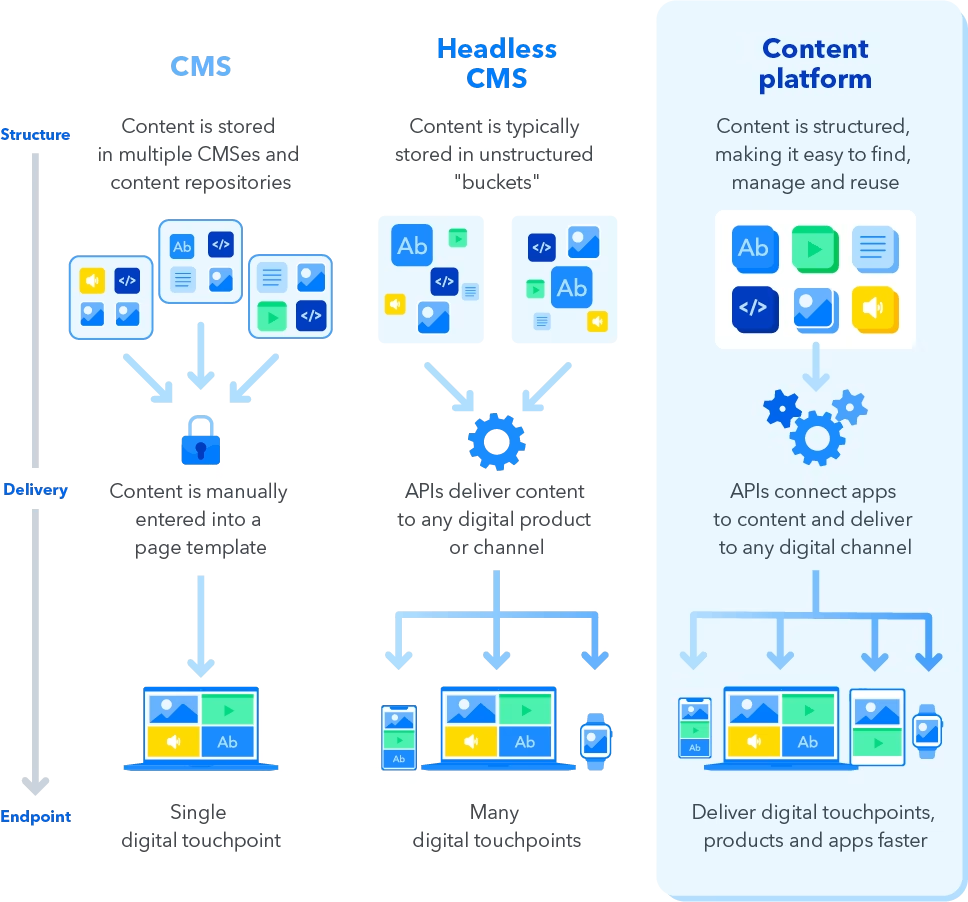TECH | September 20, 2023
Contentful Pros and Cons: A Comprehensive Analysis
*As a caveat, MCD Partners uses Contentful to build several clients project (including MCDpartners.com). However we're also versed in many other CMS's like Drupal, Wordpress, Wagtail, AEM, Sanity and others. Our goal is to always pick the right tool for the job.
At MCD Partners, we've been implementing Contentful as a headless CMS across multiple projects and clients. As veterans in the decouple space, we've navigated through multiple headless platforms and microservices. It's critical to break down these experiences for both clients and newcomers to the Contentful ecosystem, given the strong opinions surrounding it and the headless architecture as a whole.
Just like any other platform, Contentful has its champions who highlight its capabilities, often overlooking the drawbacks. On the other side, those who've had less-than-stellar experiences can be vocal critics, citing problems without necessarily considering if Contentful was even the right fit for their project in the first place.
This article aims to provide a balanced perspective to help you make an informed decision. But before we dive into the pros and cons its good to first understand what a Headless or Decouple CMS is.
What is a Headless CMS?
At its core, a Headless CMS is a content management system that decouples the back-end content repository from the front-end presentation layer. It provides content via APIs, allowing developers to use any technology stack to build the front-end. This architecture offers greater flexibility and scalability, making it easier to distribute content across multiple platforms such as websites, mobile apps, and IoT devices. Think one singular location for content across every major platform.

To delve a bit deeper into the headless CMS space we invite you to look no further than Contenfuls' Headless in 1 Minute video and article.
The Cons of Using Contentful
- Requires familiarity with API-first approach
- Content modeling can be challenging
- Not the best for full-blown e-commerce solutions (we prefer Shopify's recent investments into Remix.run, but YMMV)
- API rate limits
- May require additional costs for extended features
Requires Familiarity with API-first Approach
While Contentful offers the benefit of a headless CMS, a solid understanding of API-first development is necessary to truly leverage its capabilities. Unlike traditional CMSs where frontend and backend are tightly coupled, Contentful expects you to bring your own presentation layer. This can be a stumbling block for teams not well-versed in API-based architectures.
Content Modeling Can Be Challenging
In Contentful, you are in control of defining your own content models. While this offers flexibility, it also requires a deep understanding of your data structure needs. A poorly designed content model can create complexities down the road, especially when scaling.
Not the Best for Full-blown E-commerce Solutions
If you're looking to create an expansive e-commerce platform with complex features like multi-currency support, real-time inventory, and others, Contentful may not be the most suitable choice without additional back-end logic.
API Rate Limits
Contentful does impose API rate limits (By default the Contentful Management API enforces rate limits of 7 requests per second), which can be a drawback for websites or apps expecting high volumes of concurrent users. Depending on your plan, you may find yourself needing to optimize your API calls to stay within limits or be forced into a pricier plan.
Additional Costs for Extended Features
While Contentful offers a free tier, the more advanced features like localization, advanced roles and permissions, and some analytics features may require you to opt for a paid plan.
The Pros of Using Contentful
- Platform agnostic
- Quick content deployment and distribution
- Strong versioning and rollback features
- Reliable uptime and scalability
- Rich ecosystem and community
- It's Headless!
Platform Agnostic
One of Contentful's greatest strengths is its headless nature, allowing you to publish content across any channel, be it websites, mobile apps, or IoT devices, without being tied to any particular technology stack.
Quick Content Deployment and Distribution
Contentful's CDN-backed architecture ensures rapid deployment and low-latency access to your content worldwide. Its API-centric nature facilitates quick integrations, thus accelerating the development process.
Strong Versioning and Rollback Features
Mistakes happen. Contentful's robust versioning and rollback capabilities allow you to revert to previous states of content models and entries easily, making it forgiving for content editors.
Reliable Uptime and Scalability
Contentful offers high uptime, ensuring your content is always available. It's designed to scale as your needs grow, without requiring you to make substantial architectural changes.
Rich Ecosystem and Community
The community around Contentful is vibrant, with a wealth of tutorials, plugins, and third-party tools. This is supplemented by official documentation and support channels, making it easier to find help when you need it.
Headless Architecture
While not unique to Contentful, its worth noting that as a native headless CMS, the developer experience and consumer facing application make content distribution an absolute standout feature. Things like bring your own preview mode along with a robust and well documented SDK make working with Contentful a powerful and iterative tool with no time spent on infrastructure, dev ops or maintenance.
Wrap it up!
Contentful is not a one-size-fits-all solution, but it excels at what it is designed to do. Its limitations can often be overcome with proper planning, concise architectural decisions, and leveraging its extensibility. Like any technology, the key is to understand its strengths and weaknesses thoroughly before committing to it.
By weighing these pros and cons against your project requirements, you can make a more informed choice. Like with any technology, the potential issues with Contentful can often be mitigated through careful planning and a well-structured development approach.
Looking to move your CMS to the world of headless? Contact our team to learn more https://www.mcdpartners.com/contact
*Check out our recently updated article about the pros and cons of Drupal for similar content.